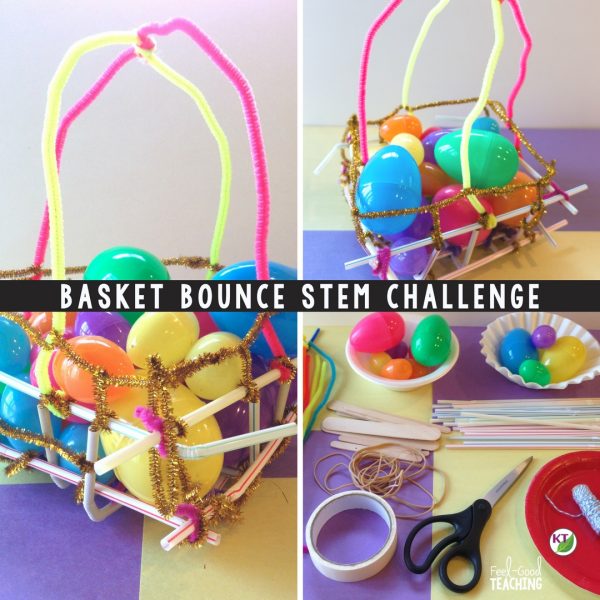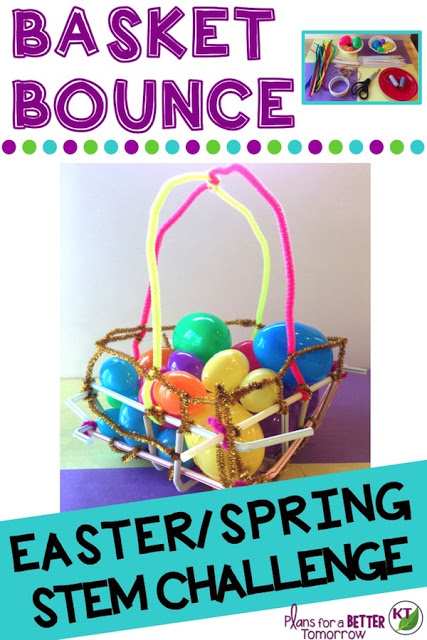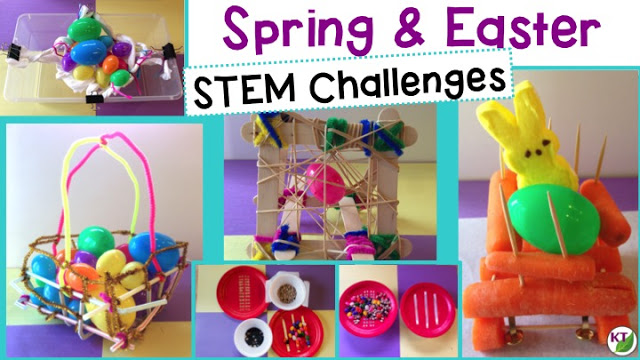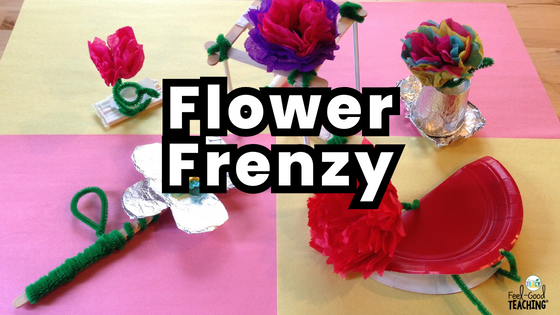Basket Bounce is another of my hybrid STEM / PE challenges. It was definitely designed with Easter in mind, but I’ve got a couple of ideas to get around that if you don’t want to (or aren’t allowed to) link it to Easter in your classroom.
Premise
Working against a criteria & constraints list, students design a basket to carry at least six eggs and keep them from falling out during the Easter Basket Bounce Relay Race. You can do this as an individual, partner, or group challenge (individual or partners is recommended).

- Straws (10 – 20)
- Pipe cleaners (10 – 20)
- Plastic eggs (6)
- Craft sticks (5 – 10)
- String/yarn (12 – 24 in.)
- Tape (12 – 24 in.)
- Rubber bands (5 – 10)
- Scissors
- Design analysis handouts (included)
Optional:
- Small cups or bowls
- Paper plates
- Cardboard or card stock
Video Walk-through
If you’re familiar with me, you know I’ve been switching over to using video to explain the bulk of my challenges. It seems to be the best/fastest way to explain the important details: materials, set-up, tips, modifications, extensions, and more! Especially in this case, where we’ve got three different relay race rules options, writing it out (and reading it for you) would take longer than either of us would want! However, if you prefer to read, you’ll find the video transcribed at the end of this post.
Instead, check out the video below to learn more about Basket Bounce:
Are There Other Spring Activities Like This?
Of course! I can’t help myself! I have created 5 challenges for Easter & spring (with plans for a few more coming soon)! You can find the overview of each on this blog post.
Video Transcription
Hi there. Welcome to our third challenge in the Spring and Easter series. This one
is called Basket Bounce, and students are going to be designing a basket to
hold 6 or more eggs in order to participate in the Basket Bounce relay race.
Now, this challenge was created, of course, with Easter in mind. If you don’t
celebrate Easter but you still want to do the challenge, you could rework this a
bit and make it either linked to Little Red Riding Hood or perhaps even a
farmer collecting eggs from chickens. Little bit of a stretch, but I think you
could make it work. Before I get ahead of myself, let’s check out the materials
and the STEM Challenge Cycle.
is called Basket Bounce, and students are going to be designing a basket to
hold 6 or more eggs in order to participate in the Basket Bounce relay race.
Now, this challenge was created, of course, with Easter in mind. If you don’t
celebrate Easter but you still want to do the challenge, you could rework this a
bit and make it either linked to Little Red Riding Hood or perhaps even a
farmer collecting eggs from chickens. Little bit of a stretch, but I think you
could make it work. Before I get ahead of myself, let’s check out the materials
and the STEM Challenge Cycle.
This is the STEM Challenge Cycle you should follow for every challenge. I’ve defined
each step in another video. I’ve added a pop-in card to that video here, as
well as a link in the description. The first part of the challenge, of course,
is to make the basket itself. You can either have students do that
individually, in partners, or in groups. I’d recommend individually or in
partners.
each step in another video. I’ve added a pop-in card to that video here, as
well as a link in the description. The first part of the challenge, of course,
is to make the basket itself. You can either have students do that
individually, in partners, or in groups. I’d recommend individually or in
partners.
There are two main criteria for this challenge. The first is that the basket must
hold at least 6 eggs, and the second is that those eggs must stay contained
within the basket while the user is running the relay race course. The main
constraint is that the eggs must be visible at all times, which means they
can’t have a complete enclosure.
hold at least 6 eggs, and the second is that those eggs must stay contained
within the basket while the user is running the relay race course. The main
constraint is that the eggs must be visible at all times, which means they
can’t have a complete enclosure.
There are several things you can do in order to make this more challenging. The first
is to require that a basket hold more than 6 eggs. The main reason I set the
initial criterion to just 6 eggs was so that you wouldn’t have to buy too many
plastic eggs. You can constrain the number of right angles or certain polygons
that are visible in the design. You can require that there be no air gaps in
the basket larger than a certain size, either by measurement or something like
a post-it note that each student can use to quickly gauge. You can add a size
constraint that none of the dimensions, length, width, or height, can exceed a
certain number, maybe 12 inches.
is to require that a basket hold more than 6 eggs. The main reason I set the
initial criterion to just 6 eggs was so that you wouldn’t have to buy too many
plastic eggs. You can constrain the number of right angles or certain polygons
that are visible in the design. You can require that there be no air gaps in
the basket larger than a certain size, either by measurement or something like
a post-it note that each student can use to quickly gauge. You can add a size
constraint that none of the dimensions, length, width, or height, can exceed a
certain number, maybe 12 inches.
Let’s get to the fun stuff. How do you run the Basket Bounce relay race? The way you
run the race will be different based on whether you had students design baskets
in groups, in partners, or individually. You’ll need to find an open space to
conduct the race. Teams need to have an even number of students, or the first
one or two students on smaller teams can take additional turns to make it a
fair race. Students on a team spread out about 5 feet apart.
run the race will be different based on whether you had students design baskets
in groups, in partners, or individually. You’ll need to find an open space to
conduct the race. Teams need to have an even number of students, or the first
one or two students on smaller teams can take additional turns to make it a
fair race. Students on a team spread out about 5 feet apart.
Option 1, baskets designed in groups. Student 1 starts with all 6 eggs in the basket.
At the go signal, student 1 bunny hops to the end of the line while students 2
through 5 bunny hop up one place in line. Once at the end of the line, student
1 passes the basket back up to the front of the line. Once student 2 gets the
basket, he or she repeats the process. This repeats until all team members have
bunny hopped the course. The relay is completed after the last team member has
hopped to the end and the basket is passed back up the line until it reaches
the student sitting at the front.
At the go signal, student 1 bunny hops to the end of the line while students 2
through 5 bunny hop up one place in line. Once at the end of the line, student
1 passes the basket back up to the front of the line. Once student 2 gets the
basket, he or she repeats the process. This repeats until all team members have
bunny hopped the course. The relay is completed after the last team member has
hopped to the end and the basket is passed back up the line until it reaches
the student sitting at the front.
Option 2, baskets designed in partners. Combine three partner groups, A, B, and C, to
form a team of 6 students. Line up according to the diagram, with the first 3
students holding their baskets. Student A1 has all the eggs in his or her
basket. At the go signal, student A1 bunny hops to the end of the line.
Everyone else hops up one place in line. Once at the end of the line, student
A1 tosses one egg at a time up the line. After tossing the last egg, A1 passes
the basket to his or her partner. When student B1 has a full basket of eggs, he
or she hops to the end of the line and the process repeats. This repeats until
all team members have bunny hopped the course. The relay is completed after the
last student has hopped to the end and all eggs are returned to the basket of
the student at the front of the line.
form a team of 6 students. Line up according to the diagram, with the first 3
students holding their baskets. Student A1 has all the eggs in his or her
basket. At the go signal, student A1 bunny hops to the end of the line.
Everyone else hops up one place in line. Once at the end of the line, student
A1 tosses one egg at a time up the line. After tossing the last egg, A1 passes
the basket to his or her partner. When student B1 has a full basket of eggs, he
or she hops to the end of the line and the process repeats. This repeats until
all team members have bunny hopped the course. The relay is completed after the
last student has hopped to the end and all eggs are returned to the basket of
the student at the front of the line.
Option 3, baskets designed individually. Students place their baskets at their feet.
Student 1 starts with all the eggs in his or her basket. At the go signal,
student 1 bunny hops to the end of the line. Students 2 through 5 bunny hop up
one place in line. Once at the end of the line, student 1 tosses one egg at a
time up to the front of the line. When student 2 has a full basket, he or she
hops to the end of the line and the process repeats. The relay is completed
after the last student has hopped to the end and all eggs are returned to the
basket of the student sitting at the front of the line.
Student 1 starts with all the eggs in his or her basket. At the go signal,
student 1 bunny hops to the end of the line. Students 2 through 5 bunny hop up
one place in line. Once at the end of the line, student 1 tosses one egg at a
time up to the front of the line. When student 2 has a full basket, he or she
hops to the end of the line and the process repeats. The relay is completed
after the last student has hopped to the end and all eggs are returned to the
basket of the student sitting at the front of the line.
Two basic rules when the students are running the course. They’ll have the basket
in one hand. They may not use the free hand to block eggs from falling out or
to catch them if they do. One way to avoid that, if you want, is to have
students hold the baskets with two hands. Now, eggs are bound to fall out, and
that’s what makes this so much fun. When that happens, the student has to put
the basket on the ground, retrieve the fallen egg, put the egg back in the
basket, but before they can continue the course, they have to do a bunny hop in
a full circle around the basket. Then they can pick it up and continue on the
course.
in one hand. They may not use the free hand to block eggs from falling out or
to catch them if they do. One way to avoid that, if you want, is to have
students hold the baskets with two hands. Now, eggs are bound to fall out, and
that’s what makes this so much fun. When that happens, the student has to put
the basket on the ground, retrieve the fallen egg, put the egg back in the
basket, but before they can continue the course, they have to do a bunny hop in
a full circle around the basket. Then they can pick it up and continue on the
course.
In order to measure the results, the teams are just going to time themselves on
how long it takes them to complete the course. Of course, they’re going to be
bound to notice if they came in first place, or third place, or last place, but
that’s not where you want to focus on measuring their results, especially if
you’re going to conduct the race multiple times. If you want the student teams
competing against themselves in order to measure their improvement over
multiple iterations, if they’re measuring how they compare to other groups,
it’s difficult to tell how much they’ve improved, because other groups might
also be improving.
how long it takes them to complete the course. Of course, they’re going to be
bound to notice if they came in first place, or third place, or last place, but
that’s not where you want to focus on measuring their results, especially if
you’re going to conduct the race multiple times. If you want the student teams
competing against themselves in order to measure their improvement over
multiple iterations, if they’re measuring how they compare to other groups,
it’s difficult to tell how much they’ve improved, because other groups might
also be improving.
I do recommend allowing the students to run the relay race more than one time. This
gives them an opportunity, even if they don’t do anything different to the
basket design, to think about their strategy and their approach as a team. It’s
important to let them test out these ideas and attempt to improve their time.
gives them an opportunity, even if they don’t do anything different to the
basket design, to think about their strategy and their approach as a team. It’s
important to let them test out these ideas and attempt to improve their time.
You can have students research how different Native American tribes honed their
basket weaving crafts. If you hold a second design iteration, you could have
students apply some of the things they learned about the Native American
tribes. You could ask the groups, given the same materials and the same design
challenge, to create their own relay race with different rules, but I would
recommend doing that only if you have time to actually try running the race
with those new rules.
basket weaving crafts. If you hold a second design iteration, you could have
students apply some of the things they learned about the Native American
tribes. You could ask the groups, given the same materials and the same design
challenge, to create their own relay race with different rules, but I would
recommend doing that only if you have time to actually try running the race
with those new rules.
You can have students identify different shapes and angles they see within the
designs. Of course, you can have students come up with their own word problems
based on the challenge. I have a couple other ideas that you will see in the
resource in just a second. You have the basics in order to do this challenge in
your class on your own, but of course, the resource is a basket full of
goodies, so take a second to check it out.
designs. Of course, you can have students come up with their own word problems
based on the challenge. I have a couple other ideas that you will see in the
resource in just a second. You have the basics in order to do this challenge in
your class on your own, but of course, the resource is a basket full of
goodies, so take a second to check it out.
This time saving resource contains everything you need, including modifications for
use with second through eight graders. You’ll still need to gather the simple
materials, of course, but the rest has been done for you. You’ll get Aligned
Next Generation Science Standards, links to my STEM Challenge How-to videos to
help you get the most from each challenge, and the Basket Bounce Materials
list. In Teacher Tips, you’ll find premise and setup, how to increase or
decrease difficulty through the criteria and constraints list, how to run the
relay race, measuring results, and cross-curricular extension suggestions.
use with second through eight graders. You’ll still need to gather the simple
materials, of course, but the rest has been done for you. You’ll get Aligned
Next Generation Science Standards, links to my STEM Challenge How-to videos to
help you get the most from each challenge, and the Basket Bounce Materials
list. In Teacher Tips, you’ll find premise and setup, how to increase or
decrease difficulty through the criteria and constraints list, how to run the
relay race, measuring results, and cross-curricular extension suggestions.
You’ll find an editable Criteria and Constraints list so you can tailor the challenge
to your students. For Student Handouts, there are two versions, four-page
expanded room for response for younger students, and a two-page condensed space
paper saver version. You’ll also find a set of group discussion questions. In
the Extension Handouts, you’ll find math practice for comparing and ordering
whole numbers and decimals, identifying common attributes in number sets,
fraction mix-up where students must unscramble four numbers to create two
fractions that add to the given sum, as well as synonym and antonym practice,
create your own word problems, and process flow templates. This resource is
available individually and as part of the discounted Easter/Spring and Mega
STEM Challenge bundles. Links can be found in the description below the video.
to your students. For Student Handouts, there are two versions, four-page
expanded room for response for younger students, and a two-page condensed space
paper saver version. You’ll also find a set of group discussion questions. In
the Extension Handouts, you’ll find math practice for comparing and ordering
whole numbers and decimals, identifying common attributes in number sets,
fraction mix-up where students must unscramble four numbers to create two
fractions that add to the given sum, as well as synonym and antonym practice,
create your own word problems, and process flow templates. This resource is
available individually and as part of the discounted Easter/Spring and Mega
STEM Challenge bundles. Links can be found in the description below the video.
If your students did Reindeer Relay back in December and had a great time with
that, they are going to love this one. Make sure you don’t forget to like and
subscribe. Have a wonderful week. I’ll see you next time.
that, they are going to love this one. Make sure you don’t forget to like and
subscribe. Have a wonderful week. I’ll see you next time.






